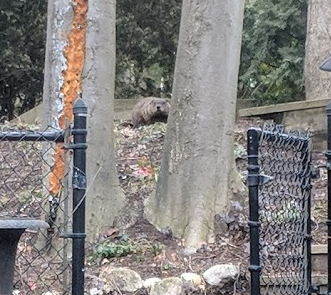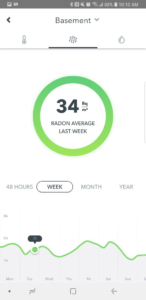
First, if you read no further, and you live in a house with a ground floor or basement, and you don’t have a Radon meter. Get one. Get this one. Yes its $250. Yes its cheaper than doing the charcoal test monthly (pays back in the year). yes its cheaper than the funeral cost of you dying from lung cancer.
First, is there such a thing as a Radon season? Yes, there is a bit, since it travels with groundwater. See that guy on the right? He’s out and about in my backyard today (no longer just feral cats!), which means spring is here (despite what he said on February 2nd).
And with spring comes melt, and with melt comes underground water. And with underground water comes Radon.
Lets examine how the ‘invisible gas of death’ gets in your house. Hey, a picture!
OK, as you can see, water is the main way its moving around. Got a sump? Put your Radon detector nearby. Got a part of the basement that’s a bit damp? Put it there!

Now, lets look at how to read it. First off, the first couple of measurements are not that accurate, so don’t stop/start worrying in your first couple of hours.
Second, yes it goes up and down. The important thing is the average. You want the long term average to be somewhere below 100 (World-Health) or 200 (Canada) recommendation. See mine on the right? Sometimes its ~60, sometimes it’s ~35. Its related to weather, how much I move around in the basement, how often the furnace runs, etc.
Third, yes, put it in the worst spot. There is no sense putting it somewhere and saying “well, that spot has Radon, but this other spot doesn’t so i’ll leave it here”. Find the worst spot, understand the level, and then decide if that is worth worrying about.
Fourth, don’t over-stress. Its not an instant quick killer, it takes time and levels of exposure.
Fifth, Radon is hyper-local. If your neighbour is good, you might not be. And vice versa. It depends on factors that vary metre by metre, and foundation by foundation. So yes, lots of the world is in a high-risk Radon zone, but that doesn’t mean you are/are not.
Here’s another graph of a local reader. See how his is more consistent than mine? But still varying?
Other local readers are seeing 130 (warning), 250 (needs resolving), 1300 (needs quick resolving), 800 (needs quick resolving), etc. And its varying day by day.


Leave a Reply to Sonya Latchman Cancel reply